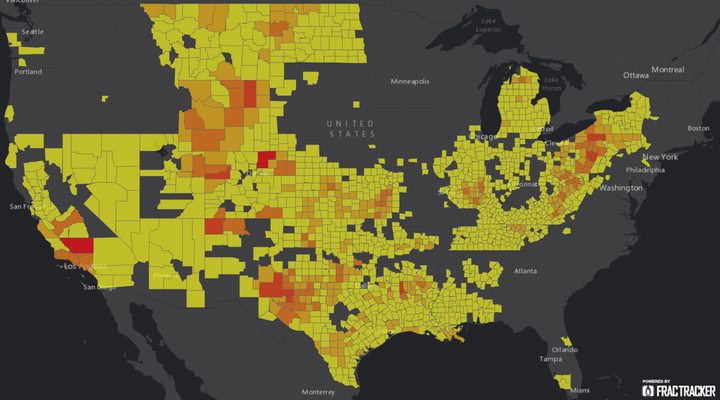OpenGov Voices: The gaps in the holes – Oil and gas drilling data inadequacies

Introduction
How many oil and gas wells are active in the United States? If you want an exact figure, good luck. The scope and pace of modern oil and gas (O&G) extraction – more generally referred to as fracking – has exploded in recent years with the advent of hydraulic fracturing, directional drilling and related exploration technologies. O&G data quality and management, unfortunately, have not kept up.
A 10-state review
Inadequacies in data transparency and quality can significantly affect the degree of public trust in the regulation of the oil and gas industry, an issue already at the forefront of many advocates concerned about the impacts of fracking. To identify data gaps and opportunities for better management, we conducted a review of data from 10 states out of 36 with active drilling. We looked at five categories of datasets that could be obtained from those states: wells drilled, violations, production (of profitable hydrocarbons), waste (non-profitable returns), and U.S. Environmental Protection Agency (EPA)-defined Class II disposal wells. The data quality criteria on which we chose to grade these datasets are as follows: accessibility, usability, point location, completeness, metadata, agency responsiveness, cost, and accuracy.
The results, recently published in February’s issue of the Journal of Environmental Science and Health, Part A[1], are striking and concerning all at the same time.

Most states did not perform well, with an average across states and data categories of 67.1 out of 100 (a failing grade on any college exam). By state, Pennsylvania received the highest average and ranked first in all but one data category. The lowest scoring state was Texas, largely due to its policy of charging for certain data.[2] Metadata and location information were often missing in the datasets that could be obtained. Overall, there was significant room for improvement by every state and across most datasets.
Data and best management practices
Best mangement practices (BMPs) help to guide all types of industrial activities, from water pollution prevention to sustainable land management. Data BMPs could also serve to improve the transparency of the widespread oil and gas industry.
Here are some suggested BMPs based on our research:
- Create a universal data management system for O&G in the United States – with models such as the Toxic Release Inventory (TRI) to guide this development.[3]
- Require more stringent data and metadata collection – including the geolocation of wells, incidents and other facilities. Datasets should be available for download, not just viewable on structured online maps.
- Provide more financial and human resources to support data management at the regulatory level.
- Recognize that these data platforms and datasets must serve multiple audiences, not just regulators or industry personnel.
A dire need for improved transparency
Regardless of whether our BMPs are adopted, it is absolutely critical to improve the state of oil and gas data transparency in the United States. This issue is in fact the chief driver behind the 2010 launch of FracTracker.org, now the non-profit FracTracker Alliance.
Unconventional O&G extraction incites many criticisms as well as support. Proponents point to the number of jobs and profits that domestic O&G extraction can offer. Those who are concerned about the impacts of the industry cite observed and potential impacts on our transportation networks, environment and public health. With such a polarizing topic, transparency is key. Precedents set by states with existing O&G development may have lasting impacts on how we expect public institutions to respond to public demands for transparency in the future. Without access to consistent and comprehensive O&G data, these debates will only continue to be muddied by a lack of adequate public knowledge about industry activities.
—–
Footnotes
[1] A select number of full text PDF’s of this article are available from the authors. Please contact Sam Malone to request one.
[2] Data were reviewed in 2013, so policies and data quality may have changed while the publication was going to print. Our analysis focused on showing how states compare to each other and the variability of the available data at a specific point in time.
[3] Currently, oil and gas drillers do not even have to report their emissions to TRI. Some states require submission of certain data to FracFocus, but data in aggregate are not available from this online resource.
Publication information: Malone S, Kelso M, Auch T, Edelstein K, Ferrar K, Jalbert K. (2015). Data inconsistencies from states with unconventional oil and gas activity. Journal of Environmental Science and Health, Part A, 50, 501–510, available online: http://dx.doi.org/10.1080/10934529.2015.992678
Interested in writing a guest blog for Sunlight? Email us at guestblog@sunlightfoundation.com

